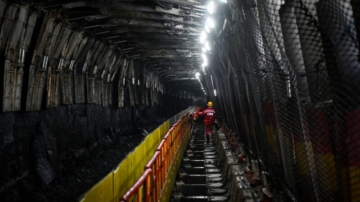【新唐人2013年04月01日訊】美國《彭博社》3月28號刊登《空氣污染、出生缺陷和中國的危機》一文。文章提到:北京大學健康科學中心及美國德州大學奧斯汀分校的研究夥伴,最近公布了一份對山西省嚴重新生兒出生缺陷的10年調查結果。研究團隊調查的是「先天性神經管缺陷」的發生頻率,他們在調查中看到了令人震驚的事實。
煤礦豐富的山西省,是中國污染最嚴重的地區之一,研究人員在10年的時間裡,收集了80個死胎或有缺陷新生兒的胎盤。他們的分析證實,這些嬰兒在子宮內被暴露於顯著濃度的農藥、工業溶劑,特別是多環芳香族碳氫化合物(PAH),這些都是化石燃料燃燒時釋放到空氣中的物質。研究人員發現,在有缺陷的嬰兒胎盤中,有較正常嬰兒胎盤更高濃度的化學品。
母親被暴露的環境與孩子的出生結果有明顯關聯。
在美國,每1萬名活產嬰兒中,有7.5名嬰兒有神經管缺陷。但在山西,這一數字是美國的18倍,也就是:每1萬名活產嬰兒中,有140名嬰兒存在神經管缺陷。
美國專業學術月刊《環境健康展望》雜誌,2008年10月發表的另一項研究發現,在重慶市關閉一個燃煤電廠後,兩組孕婦出現了明顯變化。
研究人員分別在2002年和2005年,招募了兩組不吸煙的母親和新生兒。所有這些婦女都居住在重慶市銅梁電廠2公裡以內。而電廠於2004年關閉。在這些孕婦生產時,研究人員採集了臍帶血,分析記錄了汞和鉛的存在情況。
研究人員追蹤這些孩子到他們的第二個生日,以評估他們的行為和智力發育。研究發現,2002年出生的孩子,由於當時電廠仍然運行,平均表現發育遲緩,尤其是運動技能的遲緩表現更突出。但出生於2005年的孩子們沒有表現出同樣的問題。參與研究的人員(佩雷拉)說:「這實際上是一個很好的新聞故事,政府關閉了電廠,你可以看到立竿見影的改善。」
湖北作家阮雲華表示,這個現象不是一兩年造成的。這是長期的政府工作不到位,以及政府瀆職所造成。
湖北作家阮雲華:「為了GDP不顧老百姓的生活。所以導致現在出現很多新生兒畸形發育和懷孕,都造成很大的影響。實際上已經構成了一種犯罪了。政府不作為,就導致了對老百姓生命的輕視。像我們家鄉也出現過計劃生育導致人命案的問題,也是一樣的。他們只考慮完成指標,而不考慮到老百姓的生命安全以及生活質量。」
據大陸衛生部發佈的《中國婦幼衛生事業發展報告2011年》顯示,根據全中國醫院監測數據,中國「出生缺陷發生率」呈上升趨勢,由1996年的87萬7千名,上升到2010年的149萬9千名,增幅達70.9%。2010年,醫院監測的「前五位出生缺陷種類」是:先天性心臟病32萬7千名、多指(趾)16萬4千名、總唇裂12萬8千名、先天性腦積水6萬、神經管缺陷5萬7名。共佔全部出生缺陷的49.1%。
而《廣州日報》1月4號報導,中國是新生兒出生缺陷的高發國家之一。2006年的《中國兒童發展報告》顯示,中國每年約有20萬∼30萬肉眼可見的先天畸形兒出生,加上出生後數月和數年才顯現出來的缺陷,缺陷兒總數高達80萬∼ 120萬。
今年3月號的《環境與健康展望》雜誌,刊登有關城市空氣污染和分娩結局的研究,發現空氣污染與出生缺陷有關聯。這項研究調查分析了9個國家的300萬個出生記錄,發現PM10和PM2.5的空氣懸浮顆粒濃度高都會區,導致低出生體重嬰兒的比例增加。比如每立方米的PM10濃度每增加10毫克,低體重出生嬰兒的比例就會增加3%。報導說,這項研究中並沒有納入中國的例子,而中國是PM污染最嚴重的國家之一。
採訪編輯/秦雪 後製/蕭宇
China’s Birth Defects Linked to Air Pollution, Research Shows
On Mar 28, Bloomberg published an article titled,
“Air Pollution, Birth Defects and the Risk in China.”
The article cited a research by a Princeton Global Scholar
and his partners at Peking University Health Science Center and the University of Texas, Austin.
They recently published results of a 10-year investigation
on severe birth defects in Shanxi Province, China.
Investigating the alarming frequency of congenital neural
tube defects, the researchers found astonishing results.
The coal-rich Shanxi province is one of the most polluted
regions in China.
Over 10-years, the researchers gathered placentas from
80 stillborn or born with a disorder infants in Shanxi.
Based on their analyses, they confirmed that those infants
had been exposed in utero to significant levels of pesticides,
industrial solvents, and especially PAHs (polycyclic aromatic
hydrocarbons), released in the air when burning fossil fuels.
As a result, the placentas of infants with birth defects
was found to have higher concentrations of the chemicals than that of the other infants.
The environment which pregnant women were expose to
was found to have significant correlation with the health of their infants.
In the U.S., for every 10,000 live births,
there are 7.5 infants with neural tube defects.
In contrast, in Shanxi this number is 18 times higher,
with 140 per every 10,000 infants being with birth defects.
In October 2008, another study with similar significance
was published in the US-based academic journal “Environmental Health Perspectives”.
The authors found notable difference between two groups
of women in Chongqing City, who had babies before and after the closing of a power plant nearby.
The researchers enrolled two groups of nonsmoking
mothers and their newborns in 2002 and 2005.
All the women lived within 2 kilometers of the site of
Chongqing’s Tongliang power plant, closed in 2004.
Samples of umbilical cord blood were collected at the time
of delivery and analyzed to record the presence of PAHs, mercury, and lead.
The children were observed by the researchers until their
second birthday to assess their behavioral and intellectual development.
They found that the children born in 2002, when the power
plant was still operating, showed on average developmental delays, especially in motor skills.
Those born in 2005 did not exhibit the same setbacks.
Perera, one of the researchers said,
“It’s actually a good-news story.
The government shut down the power plant, and you could
see immediate improvements (in child and maternal health).”
Ruan Yunhua, a Hubei writer remarked,
the health of babies is not a short-term issue.
The current situation results from inadequate government
efforts and its malfeasance over a long period.
Ruan Yunhua, Hubei writer: ”To pursue GDP growth,
the (Chinese Communist Party / CCP) government has ignored people’s livelihood.
Therefore right now there are so many babies
born with defects, which greatly impacts our lives.
This is already a crime. The inaction of the government
is equivalent to holding the ordinary people’s lives cheap.
In my hometown there were also mothers killed
due to forced birth control so we see the same problem.
They (the CCP authorities) only think of accomplishing
their goals, while caring little about people’s life, safety, and quality of livelihood.”
The Report on Women and Children's Health Development
in China (2011), published by China’s Ministry of Health,
showed an increasing trend in the rate of birth defects,
according to statistics collected from hospitals nationwide.
The babies with defects totaled 877,000 in 1996.
This number increased by 70.9% to 1,499,000 in 2010.
In that year, the five most frequent birth defects were:
congenital heart disease (327,000), polydactyl (164,000),
cleft lip (128,000), congenital hydrocephalus (60,000),
and neural tube defects (57,000).
These account for 49.1% of all the birth defects.
A report of Guangzhou Daily newspaper on Jan 4 revealed,
China is a country with high rate of birth defects.
The 2006’s National Report of Child Development in China
shows that each year there are around 250,000 babies with congenital problems born in China.
Further counting the babies whose defects appear several
months or years after birth, the total number of babies with health issues can reach 1.2 million.
The Environmental Health Perspectives’ journal published
a study this March, about the effect of urban air pollution on birth outcomes.
The study found a correlation between the air pollution
and the health defects in babies.
The researchers examined 3 million birth records
in nine countries.
They found a correlation between low birth weight
and high levels of PM 10 and PM 2.5.
For instance, each 10 micrograms increase of PM10
per cubic meter was found to correlate with a 3 percent increase in the number of babies with low birth weight.
However, this study did not include China, where the levels
of air pollution are generally higher than those in the nine countries studied.
煤礦豐富的山西省,是中國污染最嚴重的地區之一,研究人員在10年的時間裡,收集了80個死胎或有缺陷新生兒的胎盤。他們的分析證實,這些嬰兒在子宮內被暴露於顯著濃度的農藥、工業溶劑,特別是多環芳香族碳氫化合物(PAH),這些都是化石燃料燃燒時釋放到空氣中的物質。研究人員發現,在有缺陷的嬰兒胎盤中,有較正常嬰兒胎盤更高濃度的化學品。
母親被暴露的環境與孩子的出生結果有明顯關聯。
在美國,每1萬名活產嬰兒中,有7.5名嬰兒有神經管缺陷。但在山西,這一數字是美國的18倍,也就是:每1萬名活產嬰兒中,有140名嬰兒存在神經管缺陷。
美國專業學術月刊《環境健康展望》雜誌,2008年10月發表的另一項研究發現,在重慶市關閉一個燃煤電廠後,兩組孕婦出現了明顯變化。
研究人員分別在2002年和2005年,招募了兩組不吸煙的母親和新生兒。所有這些婦女都居住在重慶市銅梁電廠2公裡以內。而電廠於2004年關閉。在這些孕婦生產時,研究人員採集了臍帶血,分析記錄了汞和鉛的存在情況。
研究人員追蹤這些孩子到他們的第二個生日,以評估他們的行為和智力發育。研究發現,2002年出生的孩子,由於當時電廠仍然運行,平均表現發育遲緩,尤其是運動技能的遲緩表現更突出。但出生於2005年的孩子們沒有表現出同樣的問題。參與研究的人員(佩雷拉)說:「這實際上是一個很好的新聞故事,政府關閉了電廠,你可以看到立竿見影的改善。」
湖北作家阮雲華表示,這個現象不是一兩年造成的。這是長期的政府工作不到位,以及政府瀆職所造成。
湖北作家阮雲華:「為了GDP不顧老百姓的生活。所以導致現在出現很多新生兒畸形發育和懷孕,都造成很大的影響。實際上已經構成了一種犯罪了。政府不作為,就導致了對老百姓生命的輕視。像我們家鄉也出現過計劃生育導致人命案的問題,也是一樣的。他們只考慮完成指標,而不考慮到老百姓的生命安全以及生活質量。」
據大陸衛生部發佈的《中國婦幼衛生事業發展報告2011年》顯示,根據全中國醫院監測數據,中國「出生缺陷發生率」呈上升趨勢,由1996年的87萬7千名,上升到2010年的149萬9千名,增幅達70.9%。2010年,醫院監測的「前五位出生缺陷種類」是:先天性心臟病32萬7千名、多指(趾)16萬4千名、總唇裂12萬8千名、先天性腦積水6萬、神經管缺陷5萬7名。共佔全部出生缺陷的49.1%。
而《廣州日報》1月4號報導,中國是新生兒出生缺陷的高發國家之一。2006年的《中國兒童發展報告》顯示,中國每年約有20萬∼30萬肉眼可見的先天畸形兒出生,加上出生後數月和數年才顯現出來的缺陷,缺陷兒總數高達80萬∼ 120萬。
今年3月號的《環境與健康展望》雜誌,刊登有關城市空氣污染和分娩結局的研究,發現空氣污染與出生缺陷有關聯。這項研究調查分析了9個國家的300萬個出生記錄,發現PM10和PM2.5的空氣懸浮顆粒濃度高都會區,導致低出生體重嬰兒的比例增加。比如每立方米的PM10濃度每增加10毫克,低體重出生嬰兒的比例就會增加3%。報導說,這項研究中並沒有納入中國的例子,而中國是PM污染最嚴重的國家之一。
採訪編輯/秦雪 後製/蕭宇
China’s Birth Defects Linked to Air Pollution, Research Shows
On Mar 28, Bloomberg published an article titled,
“Air Pollution, Birth Defects and the Risk in China.”
The article cited a research by a Princeton Global Scholar
and his partners at Peking University Health Science Center and the University of Texas, Austin.
They recently published results of a 10-year investigation
on severe birth defects in Shanxi Province, China.
Investigating the alarming frequency of congenital neural
tube defects, the researchers found astonishing results.
The coal-rich Shanxi province is one of the most polluted
regions in China.
Over 10-years, the researchers gathered placentas from
80 stillborn or born with a disorder infants in Shanxi.
Based on their analyses, they confirmed that those infants
had been exposed in utero to significant levels of pesticides,
industrial solvents, and especially PAHs (polycyclic aromatic
hydrocarbons), released in the air when burning fossil fuels.
As a result, the placentas of infants with birth defects
was found to have higher concentrations of the chemicals than that of the other infants.
The environment which pregnant women were expose to
was found to have significant correlation with the health of their infants.
In the U.S., for every 10,000 live births,
there are 7.5 infants with neural tube defects.
In contrast, in Shanxi this number is 18 times higher,
with 140 per every 10,000 infants being with birth defects.
In October 2008, another study with similar significance
was published in the US-based academic journal “Environmental Health Perspectives”.
The authors found notable difference between two groups
of women in Chongqing City, who had babies before and after the closing of a power plant nearby.
The researchers enrolled two groups of nonsmoking
mothers and their newborns in 2002 and 2005.
All the women lived within 2 kilometers of the site of
Chongqing’s Tongliang power plant, closed in 2004.
Samples of umbilical cord blood were collected at the time
of delivery and analyzed to record the presence of PAHs, mercury, and lead.
The children were observed by the researchers until their
second birthday to assess their behavioral and intellectual development.
They found that the children born in 2002, when the power
plant was still operating, showed on average developmental delays, especially in motor skills.
Those born in 2005 did not exhibit the same setbacks.
Perera, one of the researchers said,
“It’s actually a good-news story.
The government shut down the power plant, and you could
see immediate improvements (in child and maternal health).”
Ruan Yunhua, a Hubei writer remarked,
the health of babies is not a short-term issue.
The current situation results from inadequate government
efforts and its malfeasance over a long period.
Ruan Yunhua, Hubei writer: ”To pursue GDP growth,
the (Chinese Communist Party / CCP) government has ignored people’s livelihood.
Therefore right now there are so many babies
born with defects, which greatly impacts our lives.
This is already a crime. The inaction of the government
is equivalent to holding the ordinary people’s lives cheap.
In my hometown there were also mothers killed
due to forced birth control so we see the same problem.
They (the CCP authorities) only think of accomplishing
their goals, while caring little about people’s life, safety, and quality of livelihood.”
The Report on Women and Children's Health Development
in China (2011), published by China’s Ministry of Health,
showed an increasing trend in the rate of birth defects,
according to statistics collected from hospitals nationwide.
The babies with defects totaled 877,000 in 1996.
This number increased by 70.9% to 1,499,000 in 2010.
In that year, the five most frequent birth defects were:
congenital heart disease (327,000), polydactyl (164,000),
cleft lip (128,000), congenital hydrocephalus (60,000),
and neural tube defects (57,000).
These account for 49.1% of all the birth defects.
A report of Guangzhou Daily newspaper on Jan 4 revealed,
China is a country with high rate of birth defects.
The 2006’s National Report of Child Development in China
shows that each year there are around 250,000 babies with congenital problems born in China.
Further counting the babies whose defects appear several
months or years after birth, the total number of babies with health issues can reach 1.2 million.
The Environmental Health Perspectives’ journal published
a study this March, about the effect of urban air pollution on birth outcomes.
The study found a correlation between the air pollution
and the health defects in babies.
The researchers examined 3 million birth records
in nine countries.
They found a correlation between low birth weight
and high levels of PM 10 and PM 2.5.
For instance, each 10 micrograms increase of PM10
per cubic meter was found to correlate with a 3 percent increase in the number of babies with low birth weight.
However, this study did not include China, where the levels
of air pollution are generally higher than those in the nine countries studied.








